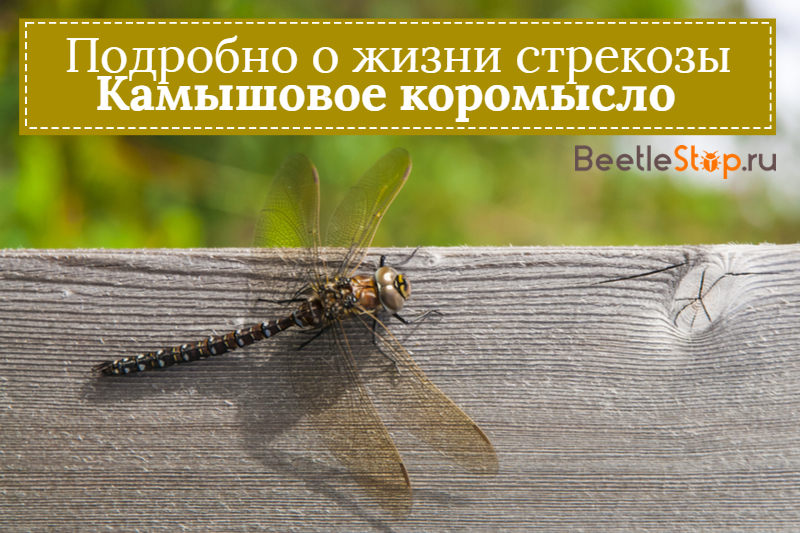Reed Rocker - a dragonfly that prefers swamps
Rocker - one of the genera of the same family, including 400 species of large dragonflies. The Latin name Aeshna is derived from the Greek word meaning shame. It is believed that the Danish scientist Fabrice, the first to describe insects, first noticed dragonflies at the time of mating. The situation pushed the researcher to a peculiar designation. In Russia, 10 species of the genus Aeshna live, the most common is the reed rocker. Dragonflies have a motley body with a predominance of blue spots.
Morphological description
The reed rocker (Aeshna juncea) belongs to the family and the genus of the rocker. One of the largest dragonflies has a body length of 70-80 mm, wingspan up to 95 mm. The head is movable, able to rotate 180 °. On the back of the head is a pattern in the form of the letter T formed by black stripes. The main part of the lateral surface is occupied by the eyes. The organ of vision consists of tens of thousands of isolated eyes, providing excellent visibility. In representatives of the genus rocker, the eyes touch in a large area. The antennae are short, the lower lip consists of three parts of the same size.

In the color of insects, sexual dimorphism is observed. The male has blue eyes, chest brown, yellow stripes on the sides and on the pronotum. The abdomen is black, on each segment there is a pattern of blue or blue spots. Brown predominates in the coloration of the female, spots on the abdomen are yellowish. Females have an ovipositor formed by four stilettos.
Information. For representatives of the species, the blue rocker is characterized by a strong narrowing of the third abdominal segment.
Belonging to the suborder of different-winged dragonflies determined the structure of the wings. The front and rear pair differ in shape and structure. Wings are transparent, venation is complex, pronounced. In a calm state directed to the sides. The limbs are black.
Interesting fact. The Russian version of the name of the family - the rocker came from the characteristic pose of the female. She lowers her abdomen down, showing males refusal of mating.
Habitat
Rocker or blue rock species is common in the northern regions of Europe, the Caucasus (Georgia, Armenia), Central Asia, Afghanistan, and Turkey. The habitat borders east to Korea, Japan. In Russia, they are found in the European part, in the south of Siberia, the Far East. Insects are common in North America. Dragonflies are often found in European mountains, flying to a height of up to 2500 m.
Lifestyle
Years of dragonflies start in June and last until October. The species is prone to flights, in search of the best places for food and development of offspring, the blue rocker flies considerable distances. Insects often settle in peat bogs at the edge of the forest. Lakes or river backwaters are chosen with dense coastal reed vegetation. Active predators spend a lot of time in the air, they destroy mosquitoes, flies, mosquitoes, horseflies. Prey grab a mouth on the fly. Gluttonous dragonflies are of great benefit to humans, reducing the number of harmful insects. To meet them having a rest on reeds is a great success, most of the time the rockers are in the air. Very shy.
Limiting factors and protection
On a global scale, nothing threatens the species, but in some regions as a result of reclamation work to drain the marshes, the natural habitat of the reed rocker is destroyed. The vitality of Aeshna juncea is supported by its tendency to scatter. The threat of water pollution and destruction of coastal vegetation is relevant for the larval stage. The reed yoke fell into the Red Book of the Tula Region as a rare and little studied species.
Larval development
Mating of insects occurs in the air. Fertilized females, using an ovipositor, place eggs in plant tissue. They can be seen on aquatic vegetation and among coastal wet mosses. Eggs are oblong with a pointed end. The masonry remains for the winter. The emergence of larvae begins in the spring.
Rocker offspring live in stagnant waters. The body is long, strong. The head is large, the eyes are convex, facet type. Antennae short, composed of sludge of seven segments.
The mask is flat, occupies the lower part of the head. This is a grasping organ necessary for catching prey. The abdomen is massive, internal gills. Coloring greenish-brown, serves as a disguise for nymphs. The edges of the last segments of the abdomen are elongated in the form of lateral spines. Larvae develop 2 years, grow up to 40-45 mm. They are predators, prey on invertebrates, caddis flies and mosquitoes, even fry. Metamorphosis occurs on land, the release of young dragonflies is extended for two months.

